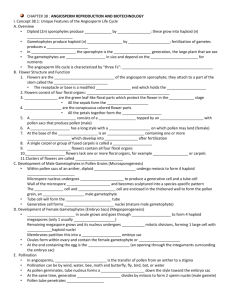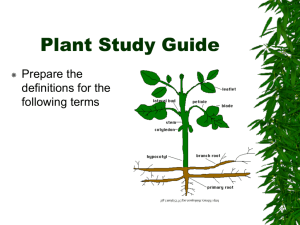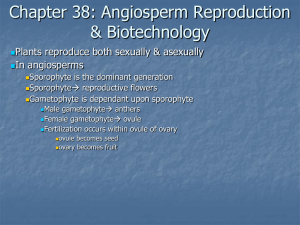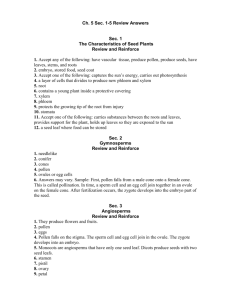CHAPTER 38
advertisement
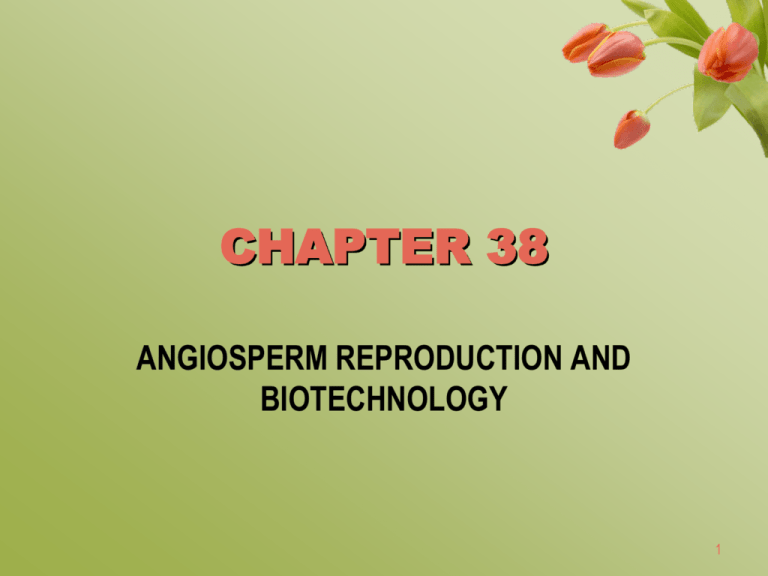
CHAPTER 38 ANGIOSPERM REPRODUCTION AND BIOTECHNOLOGY 1 Male wasps transfer pollen to an Mediterranean orchid 2 I. Concept 38.1: Unique Features of the Angiosperm Life Cycle A. Overview •Diploid (2n) sporophytes produce spores by meiosis; these grow into haploid (n) gametophytes •Gametophytes produce haploid (n) gametes by mitosis; fertilization of gametes produces a sporophyte •In angiosperms, the sporophyte is the dominant generation, the large plant that we see •The gametophytes are reduced in size and depend on the sporophyte for nutrients •The angiosperm life cycle is characterized by “three Fs”: flowers, double fertilization, and fruits 3 Angiosperm Life Cycle 4 B. Flower Structure and Function 1. Flowers are the reproductive shoots of the angiosperm sporophyte; they attach to a part of the stem called the receptacle •The receptacle or base is a modified stem end which holds the flower 2. Flowers consist of four floral organs: sepals, petals, stamens, and carpels 3. Sepals are the green leaf-like floral parts which protect the flower in the bud stage •All the sepals form the calyx 4. Petals are the conspicuous colored flower parts •All the petals together form the corolla 5 5. A stamen consists of a filament topped by an anther with pollen sacs that produce pollen (male) 6. A carpel has a long style with a stigma on which pollen may land (female) 7. At the base of the style is an ovary containing one or more ovules which develop into seeds after fertilization 8. A single carpel or group of fused carpels is called a pistil 9. Complete flowers contain all four floral organs 10.Incomplete flowers lack one or more floral organs, for example stamens or carpels 11.Clusters of flowers are called inflorescences 6 7 Flower Structure 8 Lilies 9 C. Development of Male Gametophytes in Pollen Grains (Microsporogenesis) • Within pollen sacs of an anther, diploid microsporocytes undergo meiosis to form 4 haploid microspores Microspore nucleus undergoes mitosis to produce a generative cell and a tube cell Wall of the microspore thickens and becomes sculptured into a species-specific pattern The generative cell and tube cell are enclosed in the thickened wall to form the pollen grain, an immature male gametophyte 10 • Tube cell will form the pollen tube • Generative cell forms 2 sperm nuclei (mature male gametophyte) 11 12 D. Development of Female Gametophytes (Embryo Sacs) (Megasporogenesis) •Megasporocyte in ovule grows and goes through meiosis to form 4 haploid megaspores (only 1 usually survives) Remaining megaspore grows and its nucleus undergoes 3 mitotic divisions, forming 1 large cell with 8 haploid nuclei Membranes partition this into a multicellular embryo sac 13 •Ovules form within ovary and contain the female gametophyte or embryo sac •At the end containing the egg is the micropyle (an opening through the integuments surrounding the embryo sac) 14 15 E. Pollination • In angiosperms, pollination is the transfer of pollen from an anther to a stigma • Pollination can be by wind, water, bee, moth and butterfly, fly, bird, bat, or water • As pollen germinates, tube nucleus forms a pollen tube down the style toward the embryo sac • At the same time, generative nucleus divides by mitosis to form 2 sperm nuclei (male gamete) • Pollen tube penetrates micropyle 16 17 18 Pollen Tube 19 F. Double Fertilization • After landing on a receptive stigma, a pollen grain produces a pollen tube that extends between the cells of the style toward the ovary • Double fertilization results from the discharge of two sperm from the pollen tube into the embryo sac • One sperm fertilizes the egg, and the other combines with the polar nuclei, giving rise to the triploid (3n) food-storing endosperm • After double fertilization, each ovule develops into a seed • The ovary develops into a fruit enclosing the seed(s) 20 Double Fertilization 21 Sperm Nuclei Enter Micropyle 22 G. Seed Development, Form and Function 1. Endosperm Development •Endosperm development usually precedes embryo development •In most monocots and some eudicots, endosperm stores nutrients that can be used by the seedling •In other eudicots, the food reserves of the endosperm are exported to the cotyledons 23 2. Embryo Development •The first mitotic division of the zygote is transverse, splitting the fertilized egg into a basal cell and a terminal cell •Mitosis continues to occur, eventually producing cotyledons and apical meristems 24 25 3. Structure of the Mature Seed •The embryo and its food supply are enclosed by a hard, protective seed coat •The seed enters a state of dormancy (during the last stages of maturation) •In some eudicots the embryo consists of the embryonic axis attached to two cotyledons (seed leaves) •Below the cotyledons the embryonic axis is called the hypocotyl and terminates in the radicle (embryonic root); above the cotyledons it is called the epicotyl (shoot tip with a pair of miniature leaves) 26 Eudicot Seed 27 28 •A monocot embryo has one cotyledon •Grasses, such as maize and wheat, have a special cotyledon called a scutellum which absorbs nutrients from the endosperm during germination •Two sheathes enclose the embryo of a grass seed: a coleoptile covering the young shoot and a coleorhiza covering the young root 29 Monocot Seed 30 4. Seed Dormancy •Seed dormancy increases the chances that germination will occur at a time and place most advantageous to the seedling •The breaking of seed dormancy often requires environmental cues, such as temperature or lighting changes 31 5. Seed Germination and Seedling Development •Germination depends on imbibition, the uptake of water due to low water potential of the dry seed •The radicle (embryonic root) emerges first •Next, the shoot tip breaks through the soil surface •In many eudicots, a hook forms in the hypocotyl, and growth pushes the hook above ground •The hook straightens and pulls the cotyledons and shoot tip up •In maize and other grasses, which are monocots, the coleoptile pushes up through the soil 32 Eudicot Germination 33 Monocot Germination 34 H. Fruit Form and Function 1. A fruit develops from the ovary 2. It protects the enclosed seeds and aids in seed dispersal by wind or animals 3. A fruit may be classified as dry, if the ovary dries out at maturity, or fleshy, if the ovary becomes thick, soft, and sweet at maturity 4. Fruits are also classified by their development: -Simple, a single or several fused carpels -Aggregate, a single flower with multiple separate carpels -Multiple, a group of flowers called an inflorescence 5. An accessory fruit contains other floral parts in addition to ovaries 6. Fruit dispersal mechanisms include: water, wind, animals 35 36 37 38 39 II. Concept 38.2: Plants Reproduce Sexually, Asexually, or Both A. Asexual reproduction, or vegetative reproduction, produces clones. B. Mechanisms of Asexual Reproduction 1. Fragmentation is an example in which pieces of the parent plant break off to form new individuals that are exact genetic replicas of the parent. 2. Apomixis is the asexual production of seeds from a diploid cell. (Ex: dandelions) 40 C. Agriculture uses several techniques of artificial vegetative reproduction such as grafting, growing clones from cuttings, and test-tube cloning D. Asexual reproduction can be beneficial to a successful plant in a stable environment E. Sexual reproduction generates genetic variation that makes evolutionary adaptation possible F. While some flowers self-fertilize, other have methods to prevent self-fertilization and maximize genetic variation. •One of these is self-incompatibility, in which a plant rejects its own pollen or that of a closely related plant, thus insuring cross-pollination 41 42
